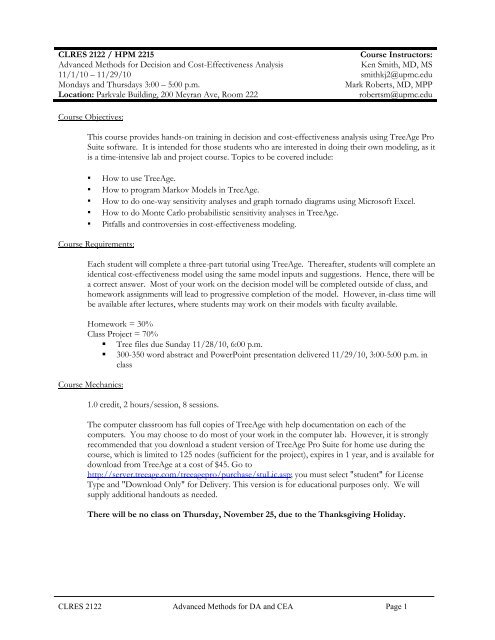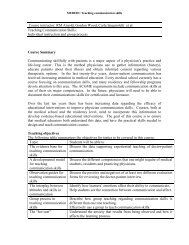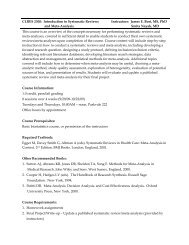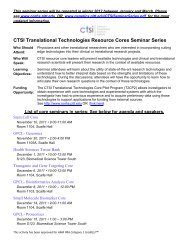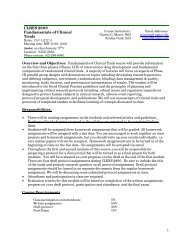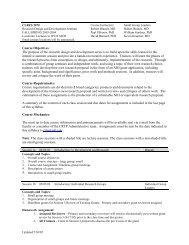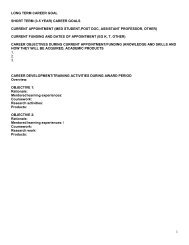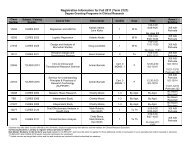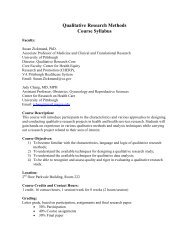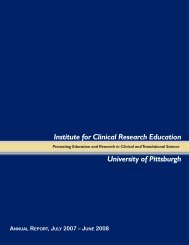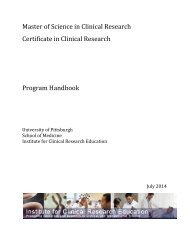Advanced Methods - Institute for Clinical Research Education
Advanced Methods - Institute for Clinical Research Education
Advanced Methods - Institute for Clinical Research Education
Create successful ePaper yourself
Turn your PDF publications into a flip-book with our unique Google optimized e-Paper software.
CLRES 2122 / HPM 2215<br />
<strong>Advanced</strong> <strong>Methods</strong> <strong>for</strong> Decision and Cost-Effectiveness Analysis<br />
11/1/10 – 11/29/10<br />
Mondays and Thursdays 3:00 – 5:00 p.m.<br />
Location: Parkvale Building, 200 Meyran Ave, Room 222<br />
Course Instructors:<br />
Ken Smith, MD, MS<br />
smithkj2@upmc.edu<br />
Mark Roberts, MD, MPP<br />
robertsm@upmc.edu<br />
Course Objectives:<br />
This course provides hands-on training in decision and cost-effectiveness analysis using TreeAge Pro<br />
Suite software. It is intended <strong>for</strong> those students who are interested in doing their own modeling, as it<br />
is a time-intensive lab and project course. Topics to be covered include:<br />
▪<br />
▪<br />
▪<br />
▪<br />
▪<br />
How to use TreeAge.<br />
How to program Markov Models in TreeAge.<br />
How to do one-way sensitivity analyses and graph tornado diagrams using Microsoft Excel.<br />
How to do Monte Carlo probabilistic sensitivity analyses in TreeAge.<br />
Pitfalls and controversies in cost-effectiveness modeling.<br />
Course Requirements:<br />
Each student will complete a three-part tutorial using TreeAge. Thereafter, students will complete an<br />
identical cost-effectiveness model using the same model inputs and suggestions. Hence, there will be<br />
a correct answer. Most of your work on the decision model will be completed outside of class, and<br />
homework assignments will lead to progressive completion of the model. However, in-class time will<br />
be available after lectures, where students may work on their models with faculty available.<br />
Homework = 30%<br />
Class Project = 70%<br />
• Tree files due Sunday 11/28/10, 6:00 p.m.<br />
• 300-350 word abstract and PowerPoint presentation delivered 11/29/10, 3:00-5:00 p.m. in<br />
class<br />
Course Mechanics:<br />
1.0 credit, 2 hours/session, 8 sessions.<br />
The computer classroom has full copies of TreeAge with help documentation on each of the<br />
computers. You may choose to do most of your work in the computer lab. However, it is strongly<br />
recommended that you download a student version of TreeAge Pro Suite <strong>for</strong> home use during the<br />
course, which is limited to 125 nodes (sufficient <strong>for</strong> the project), expires in 1 year, and is available <strong>for</strong><br />
download from TreeAge at a cost of $45. Go to<br />
http://server.treeage.com/treeagepro/purchase/stuLic.asp; you must select "student" <strong>for</strong> License<br />
Type and "Download Only" <strong>for</strong> Delivery. This version is <strong>for</strong> educational purposes only. We will<br />
supply additional handouts as needed.<br />
There will be no class on Thursday, November 25, due to the Thanksgiving Holiday.<br />
CLRES 2122 <strong>Advanced</strong> <strong>Methods</strong> <strong>for</strong> DA and CEA Page 1
Session 1 11/1 Course overview and TreeAge tutorial Smith<br />
Concepts and Topics:<br />
In this session we will introduce the mechanics of the course and discuss the project assignment, then<br />
provide an introduction to the computational aspects of decision modeling and take you through the<br />
tutorial using TreeAge Pro Suite. This will include tree construction (branches, nodes, probabilities,<br />
values) and tree evaluation (average out/fold back).<br />
Required Reading (during the session)<br />
1. Sanders GD, Bayoumi AM, Sundaram V, et al. Cost-effectiveness of screening <strong>for</strong> HIV in the<br />
era of highly active antiretroviral therapy. N Engl J Med. 2005;352:570-85.<br />
Session 2 11/4 Tree Building and Assigning Health States Smith<br />
Concepts and Topics:<br />
In this session we will discuss basic tree building concepts, assigning health states in a Markov model,<br />
and the simplifying assumptions they entail.<br />
Required Reading (prior to session):<br />
1. Detsky AS, Naglie G, Krahn MD, Redelmeier DA, Naimark D. Primer on medical decision<br />
analysis: Part 2--Building a tree. Med Decis Making 1997;17:126-35.<br />
2. Naimark D, Krahn MD, Naglie G, Redelmeier DA, Detsky AS. Primer on medical decision<br />
analysis: Part 5--Working with Markov processes. Med Decis Making 1997;17:152-9.<br />
Homework: Assign Markov health states <strong>for</strong> the project – bubble diagram and tree <strong>for</strong>mat (due 11/8)<br />
Session 3 11/8 Mathematical concepts in modeling Smith<br />
Concepts and Topics:<br />
In this session we will discuss mathematical concepts you will have been exposed to in the tutorial:<br />
the half-cycle correction, accounting <strong>for</strong> competing causes of mortality, and rates and probabilities<br />
Required Reading (prior to session):<br />
1. Sonnenberg FA, Beck JR. Markov models in medical decision making: a practical guide. Medical<br />
Decision Making 1993;13:322-338).<br />
2. National Vital Statistics Report, United States Life Tables, 2001.<br />
Homework: Apply half cycle correction and life table mortality into tree (due 11/11)<br />
Session 4 11/11 Sensitivity Analysis Smith<br />
Concepts and Topics:<br />
This session will cover one-way sensitivity analyses and their use in “de-bugging” trees. Additionally,<br />
students will be walked through a method <strong>for</strong> graphically representing the results of one-way<br />
sensitivity analyses in a tornado diagram. Finally, we will review the concept, already introduced in<br />
the tutorial, of probabilistic (or 2 nd order Monte Carlo) sensitivity analyses.<br />
Required Reading (prior to session):<br />
1. Krahn MD, Naglie G, Naimark D, Redelmeier DA, Detsky AS. Primer on medical decision analysis:<br />
Part 4--Analyzing the model and interpreting the results. Med Decis Making 1997;17:142-51<br />
2. Briggs AH, Goeree R, Blackhouse G, O’Brien BJ. Probabilistic analysis of cost-effectiveness models:<br />
choosing between treatment strategies <strong>for</strong> gastroesophageal reflux disease. Medical Decision Making<br />
2002; 22:290-308.<br />
Homework: Semi-working model (due 11/18)<br />
CLRES 2122 <strong>Advanced</strong> <strong>Methods</strong> <strong>for</strong> DA and CEA Page 2
Session 5 11/15 Representing uncertainty in CEA results Smith<br />
Concepts and Topics:<br />
Newer techniques, such as acceptability curves, will be discussed as well as challenges <strong>for</strong> future costeffectiveness<br />
research.<br />
Required Reading (prior to session):<br />
1. Briggs AH, O'Brien BJ, Blackhouse G. Thinking outside the box: recent advances in the analysis and<br />
presentation of uncertainty in cost-effectiveness studies. Annu Rev Public Health 2002;23:377-401.<br />
Session 6 11/18 Value of in<strong>for</strong>mation analysis Smith<br />
Concepts and Topics:<br />
Value of in<strong>for</strong>mation analysis and its major product, the expected value of perfect in<strong>for</strong>mation, will<br />
be discussed. This technique shows great promise as an aid <strong>for</strong> decision making and <strong>for</strong> future<br />
research resource allocation.<br />
Required Reading (prior to session):<br />
1. Claxton K, Sculpher M, Drummond M. A rational framework <strong>for</strong> decision making by the National<br />
<strong>Institute</strong> For <strong>Clinical</strong> Excellence (NICE). Lancet. 2002;360:711-5.<br />
Session 7 11/22 Accounting <strong>for</strong> future costs Roberts<br />
Concepts and Topics:<br />
Handling of “unrelated” future costs of health care, an area of unresolved controversy, will be<br />
considered.<br />
Required Reading (prior to session):<br />
1. Meltzer D. Accounting <strong>for</strong> future costs in medical cost-effectiveness analysis. Journal of Health<br />
Economics 1997;16(1):33-64. (okay to skip Section 2 if you are not mathematically oriented)<br />
Session 8 11/29 Student Presentations Smith/Roberts<br />
Concepts and Topics:<br />
In this session students will present their findings in a <strong>for</strong>mal PowerPoint presentation (10 minutes<br />
maximum) and be critiqued by Drs. Smith and Roberts.<br />
CLRES 2122 <strong>Advanced</strong> <strong>Methods</strong> <strong>for</strong> DA and CEA Page 3


